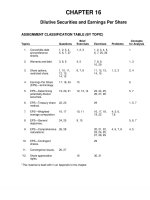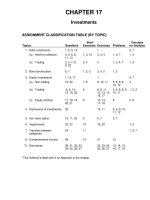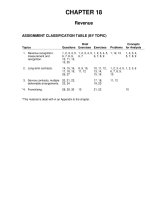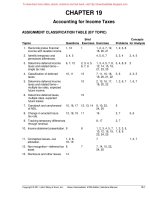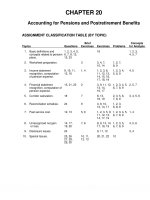Intermediate accounting IFRS 3rd ch23
Bạn đang xem bản rút gọn của tài liệu. Xem và tải ngay bản đầy đủ của tài liệu tại đây (2.85 MB, 81 trang )
Prepared by
Coby Harmon
University of California, Santa Barbara
23-1
Westmont College
CHAPTER 23
Statement of Cash Flows
LEARNING OBJECTIVES
After studying this chapter, you should be able to:
1.
Describe the usefulness and format of the statement of
4.
cash flows.
2.
3.
Prepare a statement of cash flows.
of cash flows.
5.
Explain the use of a worksheet in preparing a
statement of cash flows.
Contrast the direct and indirect methods of calculating
net cash flow from operating activities.
23-2
Discuss special problems in preparing a statement
PREVIEW OF CHAPTER 23
Intermediate Accounting
IFRS 3rd Edition
Kieso ● Weygandt ● Warfield
23-3
LEARNING OBJECTIVE 1
Statement of Cash Flows
Describe the usefulness and format of the statement
of cash flows.
Primary purpose:
To provide information about a company’s cash receipts and cash payments during a period.
Secondary objective:
To provide cash-basis information about the company’s operating, investing, and financing
activities.
23-4
LO 1
Statement of Cash Flows
Usefulness of the Statement of Cash Flows
Provides information to help assess:
23-5
1.
Entity’s ability to generate future cash flows.
2.
Entity’s ability to pay dividends and meet obligations.
3.
Reasons for the difference between net income and net cash flow from operating activities.
4.
Cash and non-cash investing and financing transactions during the period.
LO 1
Statement of Cash Flows
Classification of Cash Flows
Operating Activities
Income Statement Items
Investing Activities
Financing Activities
Changes in Investments
Changes in Equity and
and Other Non-Current
Non-Current Liability Items
Asset Items
23-6
LO 1
Classification of Cash Flows
ILLUSTRATION 23.1
Classification of
Typical Cash Inflows and Outflows
23-7
LO 1
Classification of Cash Flows
ILLUSTRATION 23.1
Classification of Typical Cash Inflows and Outflows
23-8
LO 1
Cash and Cash Equivalents
The basis recommended by the IASB for the statement of cash flows is actually “cash and cash
equivalents.” Cash equivalents are short-term, highly liquid investments that are both:
Readily convertible to known amounts of cash, and
So near their maturity that they present insignificant risk of changes value in (e.g., due to changes in
interest rates).
Generally, only investments with original maturities of three months or less qualify under this definition.
23-9
LO 1
Product Life
Cycle
23-10
Format of the Statement of Cash Flows
Presentation:
1.
Operating activities.
Direct Method
2.
Investing activities.
Indirect Method
3.
Financing activities.
Report inflows and outflows from investing and financing activities separately.
23-11
LO 1
ILLUSTRATION 23.2
Format of the Statement of Cash Flows
23-12
LO 1
Preparing the Statement of Cash Flows
LEARNING OBJECTIVE 2
Prepare a statement of cash flows.
Three Sources of Information:
1.
Comparative statements of financial position.
2.
Current income statement data.
3.
Selected transaction data.
Three Major Steps:
23-13
Step 1.
Determine change in cash.
Step 2.
Determine net cash flow from operating activities.
Step 3.
Determine net cash flows from investing and financing activities.
LO 2
Illustrations—Tax Consultants Inc.
Illustration: Tax Consultants Inc. started on January 1, 2019, when it issued 60,000 shares of $1 par value
common stock for $60,000 cash. The company rented its office space, furniture, and equipment, and
performed tax consulting services throughout the first year.
The comparative statements of financial position at the beginning and end of the year 2019 appear in
Illustration 23.3. Illustration 23.4 shows the income statement and additional information for Tax
Consultants.
23-14
LO 2
ILLUSTRATION 23.3
Comparative Statements of Financial Position, Tax
Consultants Inc., Year 1
ILLUSTRATION 23.4
Income Statement, Tax Consultants
Inc., Year 1
23-15
Illustrations—Tax Consultants Inc.
Step 1: Determine the Change in Cash
ILLUSTRATION 23.3
Comparative statements of financial position, Tax Consultants Inc., Year 1
23-16
LO 2
Illustrations—Tax Consultants Inc.
Step 2: Determine the Net Cash Flow from Operating Activities
Company must determine revenues and expenses on a cash basis.
Eliminate the effects of income statement transactions that do not result in an increase or decrease in
cash.
Convert net income to net cash flow from operating activities through either a direct method or an
indirect method.
23-17
LO 2
Illustrations—Tax Consultants Inc.
Step 2: Determine the Net Cash Flow from Operating Activities
ILLUSTRATION 23.5
Net Income versus Net Cash Flow from Operating Activities
23-18
LO 2
Illustrations—Tax Consultants Inc.
Increase in Accounts Receivable—Indirect Method
Accounts receivable increased by $36,000 (from $0 to $36,000) during the year.
ILLUSTRATION 23.6
Accounts Receivable
1/1/19
12/31/19
Balance
0
Revenues
125,000
Balance
36,000
Receipts from customers 89,000
When the Accounts Receivable balance increases, cash receipts are lower than revenue earned under the accrual
basis.
23-19
LO 2
Illustrations—Tax Consultants Inc.
Increase in Accounts Receivable—Indirect Method
ILLUSTRATION 23.6
Accounts Receivable
1/1/19
12/31/19
Balance
0
Revenues
125,000
Balance
36,000
Receipts from customers 89,000
The increase in accounts receivable is subtracted from net income to arrive at net cash provided by operating activities.
ILLUSTRATION 23.7
23-20
LO 2
Illustrations—Tax Consultants Inc.
Increase in Accounts Payable—Indirect Method
Accounts payable increased by $5,000 during the year.
When accounts payable increase during the year, expenses on an accrual basis exceed those on a cash basis.
ILLUSTRATION 23.7
23-21
LO 2
Step 3: Determine
Net Cash Flows from
Investing and
Financing Activities
TAX CONSULTANTS INC.
Statement of Cash Flows
For The Year Ended December 31, 2019
ILLUSTRATION 23.8
23-22
ILLUSTRATION 23.3
Step 3: Determine
Net Cash Flows from
Investing and
Financing Activities
TAX CONSULTANTS INC.
Statement of Cash Flows
For The Year Ended December 31, 2019
ILLUSTRATION 23.8
23-23
ILLUSTRATION 23.3
Step 3: Determine
Net Cash Flows from
Investing and
Financing Activities
TAX CONSULTANTS INC.
Statement of Cash Flows
For The Year Ended December 31, 2019
ILLUSTRATION 23.8
23-24
ILLUSTRATION 23.3
Step 3: Determine
Net Cash Flows from
Investing and
Financing Activities
TAX CONSULTANTS INC.
Statement of Cash Flows
For The Year Ended December 31, 2019
ILLUSTRATION 23.8
23-25
ILLUSTRATION 23.3





